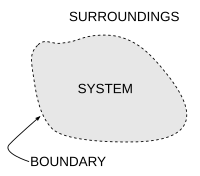Thanks to a conversation with Stewart Young from OSIsoft where we were bouncing around different ideas and the latest Green Grid meeting it hit me. As much as The Green Grid and folks there discuss power and cooling systems is there a different way to think about how to green the data center.
By its nature The Green Grid with its vendor members will organize itself around those things that sell the vendors products. PUE drives energy efficiency benchmarking which gets people to upgrade equipment. Energy efficient servers the same.
So, let’s go to a different holistic view of the green data center problem. Looking at the Data Center as a Thermodynamic System.
In thermodynamics, a thermodynamic system, originally called a working substance, is defined as that part of the universe that is under consideration. Anything under consideration is called a system. A hypothetical boundary separates the system from the rest of the universe, which is referred to as the environment, surroundings, or reservoir.
If the data center is the system and the boundary is the physical connections to the rest of the surroundings does this work for data centers.
A useful classification of thermodynamic systems is based on the nature of the boundary and the quantities flowing through it, such as matter, energy, work, heat, and entropy. A system can be anything, for example a piston, a solution in a test tube, a living organism, an electrical circuit, a planet, etc.
Data Centers are closed systems.
Closed systems are able to exchange energy (heat and work) but not matter with their environment. A greenhouse is an example of a closed system exchanging heat but not work with its environment. Whether a system exchanges heat, work or both is usually thought of as a property of its boundary.
Data centers are actually composed of bunch of thermodynamic systems. Like:
[edit]PsychrometryPsychrometry is the study of air and water vapor mixtures for air conditioning. For this application, air is taken to be a mixture of nitrogen and oxygen with the other gases being small enough so that they can be approximated by more of nitrogen and oxygen without much error. In this psychrometry section, vapor refers to water vapor. For air at normal (atmospheric) pressure, the saturation pressure of vapor is very low. Also, air is far away from its critical point in those conditions. Thus, the air vapor mixture behaves as an ideal gas mixture. If the partial pressure of the vapor is smaller than the saturation pressure for water for that temperature, the mixture is called unsaturated. The amount of moisture in the air vapor mixture is quantified by its humidity.
…
Diesel Cycle
The Diesel cycle is the idealized cycle for compression ignition engines (ones that don't use a spark plug). The difference between the Diesel cycle and the Otto cycle is that heat is supplied at constant pressure.
- Heat is supplied reversibly at constant pressure in 1-2.
- Reversible adiabatic expansion during which work is done in 2-3.
- Heat is rejected reversibly at constant volume in 3-4.
- Gas is compressed reversibly and adiabatically in 4-1.
An example of Thermodynamic Systems in Data Centes is Syracuse University Data Center. When you watch the video it discusses many ideas you would use if you looked at the data center as a Thermodynamic System.
Maybe we need more thermodynamic engineers working on data centers? How many data center design firms take a thermodynamic system approach? Low PUE is the current topic, but what happens if you do as IBM did and brought power generation on site and change the boundary of the system?

